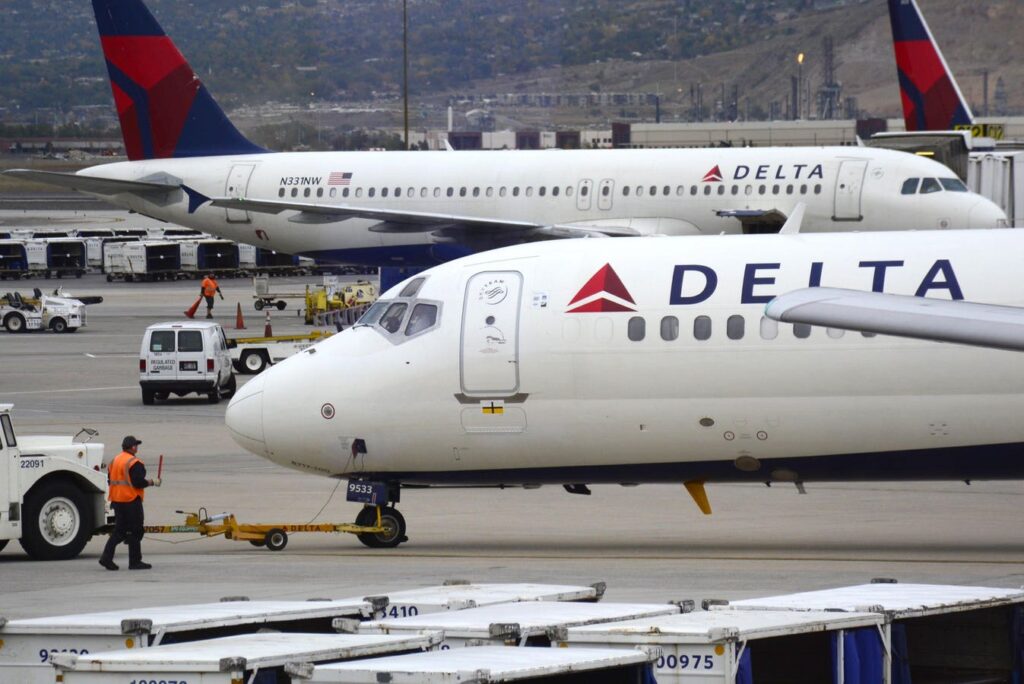SALT LAKE CITY, UT – OCTOBER 28, 2015: Delta Airlines passenger planes at Salt Lake City … More
Airlines entered 2025 with high optimism. In January, Delta expected the year to be the best financial performance in its 100 year history on the back of expected revenue growth of 7%. In December of last year, the International Air Transport Association (IATA) forecast the industry to exceed, for the first time, $1 Trillion in global airline revenue for 2025 noting that the major challenges were obtaining enough aircraft to meet burgeoning travel demand.
Then, with the arrival of the new Administration, the outlook quickly changed as the threat and reality of tariffs upended geopolitical relationships and economic markets. Earlier this month, Delta could not confirm its earlier financial guidance for 2025, which it had posited a month earlier, while cutting its first quarter earnings outlook citing weakness in both leisure and corporate bookings.
Delta CEO Ed Bastian stated “In the last six weeks, we’ve seen a corresponding reduction in broad consumer confidence and corporate confidence,” and that demand was “quite good” in January but things “really started to slow” in mid-February.
SAN ANTONIO, TEXAS – DECEMBER 12, 2018: A United Airlines Boeing 737 passenger jet takes off at San … More
United Airlines, in their recent earnings report a week ago, offered two forecasts – reflecting the uncertainty in market outlook. While confirming full year guidance, they provided a second forecast should the US economy slip into a recession.
“The Company’s outlook is dependent on the macro environment which the Company believes is impossible to predict this year with any degree of confidence,” United stated in a filing with the SEC.
This sums up the dilemma facing the country and the world. In the face of policy zig-zags and on-again/off-again pronouncements, the prudent stance is to hold fast, keep one’s powder dry and avoid further risk.
For consumers, it means avoiding booking the trip to Europe or the Rocky Mountains national park. For businesses, it means reducing fixed costs if possible and preparing for contingencies. All of these actions are showing up in airline travel which is perennially the early indicator of consumer confidence and business growth outlook.
Of course, this is merely the tip of the iceberg. This is the “deer in the headlights” phase of reaction. The true costs of tariffs has yet to manifest itself, although a few indicators are popping up.
– Bookings for the next several months between Canada and the US are down by as much as 70%.
– Air France/KLM has reduced international coach fares in the face of “softness”.
– Xianamen Airlines rejected two Boeing jets for delivery due to prices that had doubled under tariffs on China.
– Two days ago, DHL Express suspended shipments to the US worth more than $800 due to increased customs clearance expenses occasioned by a change in formal entry processing. Previously the limit was $2,500 value, but was lowered by US Customs earlier this month.
Cost increases through the value chain will take months to appear as will corresponding inflation. Airlines are currently hoping for a recovery of demand in the latter half of the year, but the coming hits to consumers’ wallets and further belt tightening are already baked into the cake due to the erratic moves of the past month with regards to global trade.
Airlines play in two time domains. Their passengers book with lead times measured in weeks or months, but they must plan for capacity in terms of years or decades, because of the lead time to actually receive the aircraft that were purchased years earlier.
In their planning scenarios, they all expect to enter promising markets which will improve pricing, capture share and propel growth. The net effect is an over expectation of needed aircraft in the system, since multiple competitors are ordering aircraft to satisfy the same underlying demand.
The combination of Boeing production stoppages through the past years and COVID has left the industry short of two to three thousand aircraft that would have been supplied on a steady state basis. As a result, both Airbus and Boeing have production backlogs as long as seven or more years.
These backlogs were built up in an era of nearly “free” money in terms of borrowing costs and before COMAC, the Chinese aircraft producer, had really achieved production maturity.
As the US government continues to careen wildly through its trade strategy, if one can call it that, it is not too wild a conjecture to imagine a supply constrained world quickly shifting to one of demand shortfall.
In the world of aircraft production, the result is cancellation of production orders for future years and delay of near term deliveries. Robust backlogs can evaporate as mindsets move from abundance to scarcity.
Economies are fundamentally based on expectations. Recessions occur when there is an expectation of difficulty ahead. It is why bank runs occur.
An Administration that prizes surprise headlines each day, to fasten attention on the topic du jour, is creating the conditions for tenuous and confused outlooks.
Worse, the airline industry – which is the poster child for globalization – could in times of difficulty, traditionally shift its assets to different parts of the globe to weather a Euro zone downturn or an Asian flu. The resilience of a globally distributed system is a factor that has been sadly overlooked in the rush to protectionism.
Unfortunately, the current US actions, as the world’s economic leader, are providing a systemic shock, not a regional dislocation, and that has dire consequences for not just the airline industry, but for its aircraft producers and industries beyond.


